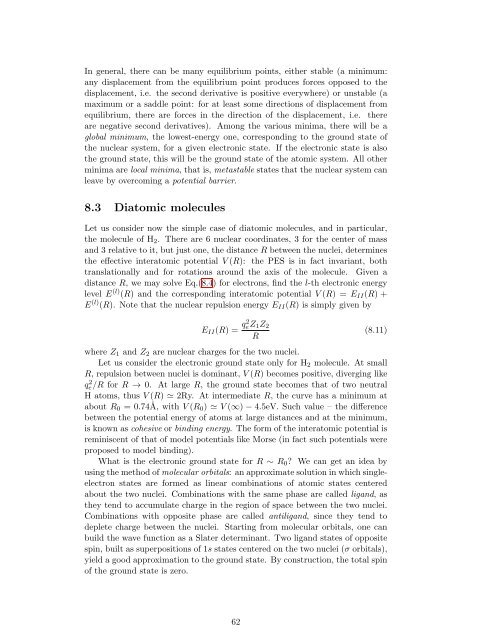Numerical Methods in Quantum Mechanics - Dipartimento di Fisica
Numerical Methods in Quantum Mechanics - Dipartimento di Fisica
Numerical Methods in Quantum Mechanics - Dipartimento di Fisica
Create successful ePaper yourself
Turn your PDF publications into a flip-book with our unique Google optimized e-Paper software.
In general, there can be many equilibrium po<strong>in</strong>ts, either stable (a m<strong>in</strong>imum:<br />
any <strong>di</strong>splacement from the equilibrium po<strong>in</strong>t produces forces opposed to the<br />
<strong>di</strong>splacement, i.e. the second derivative is positive everywhere) or unstable (a<br />
maximum or a saddle po<strong>in</strong>t: for at least some <strong>di</strong>rections of <strong>di</strong>splacement from<br />
equilibrium, there are forces <strong>in</strong> the <strong>di</strong>rection of the <strong>di</strong>splacement, i.e. there<br />
are negative second derivatives). Among the various m<strong>in</strong>ima, there will be a<br />
global m<strong>in</strong>imum, the lowest-energy one, correspond<strong>in</strong>g to the ground state of<br />
the nuclear system, for a given electronic state. If the electronic state is also<br />
the ground state, this will be the ground state of the atomic system. All other<br />
m<strong>in</strong>ima are local m<strong>in</strong>ima, that is, metastable states that the nuclear system can<br />
leave by overcom<strong>in</strong>g a potential barrier.<br />
8.3 Diatomic molecules<br />
Let us consider now the simple case of <strong>di</strong>atomic molecules, and <strong>in</strong> particular,<br />
the molecule of H 2 . There are 6 nuclear coord<strong>in</strong>ates, 3 for the center of mass<br />
and 3 relative to it, but just one, the <strong>di</strong>stance R between the nuclei, determ<strong>in</strong>es<br />
the effective <strong>in</strong>teratomic potential V (R): the PES is <strong>in</strong> fact <strong>in</strong>variant, both<br />
translationally and for rotations around the axis of the molecule. Given a<br />
<strong>di</strong>stance R, we may solve Eq.(8.4) for electrons, f<strong>in</strong>d the l-th electronic energy<br />
level E (l) (R) and the correspond<strong>in</strong>g <strong>in</strong>teratomic potential V (R) = E II (R) +<br />
E (l) (R). Note that the nuclear repulsion energy E II (R) is simply given by<br />
E II (R) = q2 eZ 1 Z 2<br />
R<br />
(8.11)<br />
where Z 1 and Z 2 are nuclear charges for the two nuclei.<br />
Let us consider the electronic ground state only for H 2 molecule. At small<br />
R, repulsion between nuclei is dom<strong>in</strong>ant, V (R) becomes positive, <strong>di</strong>verg<strong>in</strong>g like<br />
q 2 e/R for R → 0. At large R, the ground state becomes that of two neutral<br />
H atoms, thus V (R) ≃ 2Ry. At <strong>in</strong>terme<strong>di</strong>ate R, the curve has a m<strong>in</strong>imum at<br />
about R 0 = 0.74Å, with V (R 0 ) ≃ V (∞) − 4.5eV. Such value – the <strong>di</strong>fference<br />
between the potential energy of atoms at large <strong>di</strong>stances and at the m<strong>in</strong>imum,<br />
is known as cohesive or b<strong>in</strong>d<strong>in</strong>g energy. The form of the <strong>in</strong>teratomic potential is<br />
rem<strong>in</strong>iscent of that of model potentials like Morse (<strong>in</strong> fact such potentials were<br />
proposed to model b<strong>in</strong>d<strong>in</strong>g).<br />
What is the electronic ground state for R ∼ R 0 ? We can get an idea by<br />
us<strong>in</strong>g the method of molecular orbitals: an approximate solution <strong>in</strong> which s<strong>in</strong>gleelectron<br />
states are formed as l<strong>in</strong>ear comb<strong>in</strong>ations of atomic states centered<br />
about the two nuclei. Comb<strong>in</strong>ations with the same phase are called ligand, as<br />
they tend to accumulate charge <strong>in</strong> the region of space between the two nuclei.<br />
Comb<strong>in</strong>ations with opposite phase are called antiligand, s<strong>in</strong>ce they tend to<br />
deplete charge between the nuclei. Start<strong>in</strong>g from molecular orbitals, one can<br />
build the wave function as a Slater determ<strong>in</strong>ant. Two ligand states of opposite<br />
sp<strong>in</strong>, built as superpositions of 1s states centered on the two nuclei (σ orbitals),<br />
yield a good approximation to the ground state. By construction, the total sp<strong>in</strong><br />
of the ground state is zero.<br />
62
















